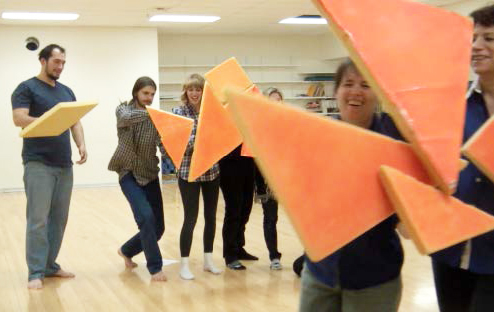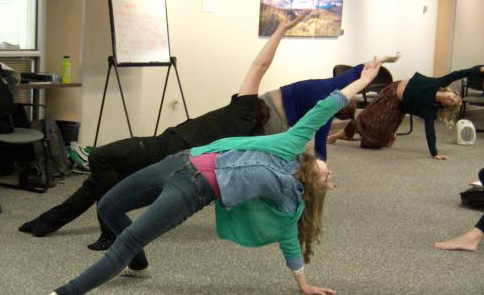Weber State University professors in mathematics and performing arts are combining their knowledge to host a workshop for secondary mathematics educators, June 11-15 in the Val A. Browning Center Room 38.

Participants in this weeklong summer workshop won’t sit behind rows of desks to learn new ways of teaching mathematic concepts. Instead, they will move around to warm up, work with others and solve dance problems by creating and arranging movements.
Erik Stern, dance professor, and Rachel Bachman, mathematics assistant professor, will incorporate an approach to teaching mathematics through dance by drawing on physical problem-solving methods. This learning approach to teaching mathematics integrates kinesthetic, creative and interpersonal concepts.
“Math can be accessible, but it’s often not taught that way,” Stern said. “There are ways to engage the whole person.”
Twenty-five educators will attend the workshop. They will learn how to explore mathematics by starting with the concrete — palpable, physical problems — before shifting to the abstract — mathematical symbols. This method grounds mathematical concepts in physical movement, engaging both the body and breath in learning.
Bachman said she started implementing this approach in her own math class soon after meeting Stern. Once she did so, she noticed a change in the way her students responded and learned.
“I used to ignore everything but my students’ minds in the classroom,” Bachman said. “I thought they were just brains that I had to put information into. But we all have moments when we need to get up and get a drink of water or take a walk. If I involve the body in learning, it helps regulate emotion and tends to the body’s needs.”
This isn’t the first time the arts and mathematics have been combined in a WSU classroom. A semester-long pilot course called Pattern Play was held in 2014. Stern taught the course with WSU math associate professor Julian Chan. It was open to all students at the university, and it satisfied general education credit requirements for mathematics and creative arts.
Bachman assessed the class, and the results demonstrated the effectiveness of the method. Students in Pattern Play outperformed students in a traditional general education mathematics course covering the same topics.
The Pattern Play students showed better mathematics content knowledge, more positive attitudes toward the subject and more persistence in problem solving.
“I was doing problem-solving interviews with students, and I witnessed something that, at the time, I really didn’t see my own students doing well with,” Bachman said. “A lot of times in math, mathematicians will look at something and think, ‘I’m not sure how to solve that, let me dive in and try stuff.’ It’s very hard to get novice students to do that, especially students who are math anxious.”
Bachman found that the Pattern Play students were more willing to experiment. “They just persisted and persisted and persisted with these problems,” she said.
Stern and Bachman hope teachers who attend the workshop will enjoy the same breakthrough with their students, particularly those who have had negative past experiences with mathematics.
“It’s a major stumbling block to many students’ successes,” Stern said of math. “There are students who don’t graduate from college, don’t get a degree or don’t advance because of that.”
As part of the workshop application process, teachers wrote essays about their teaching experiences. Many were frustrated because they had smart students who were failing math. They said they are looking for more accessible ways to teach their lesson plans.
“This is a very well-established method to get at the broader human experience, not just the symbols, as a way to understand mathematics,” Stern said. “It connects the abstract to concrete, and that’s how you create understanding.”
Stern’s experience with math and dance dates back 20+ years to the dance company he co-directs in California. He and his colleague Karl Schaffer began to notice similarities in the two subjects, such as pattern recognition, pattern manipulation and expression. It didn’t take long for this simple idea to become an entire routine and outreach show, which they performed 600 times throughout North America.
“We started by looking at dances we’d already choreographed, and finding the mathematic principles,” Stern said. “Then there was cross pollination. The math would inspire the choreography, and the choreography would inspire mathematical thinking.”
Over time, their company received more and more requests to help teachers learn how to implement these ideas in their own classrooms. They began writing lesson plans and pioneered this particular method of teaching.
Though he has taught teachers for decades, Stern said this summer’s workshop will be the longest and most intensive one he’s been involved with to date. The in-depth nature of the workshop is made possible by a $25,000 Browning Foundation Grant. Thanks to that funding, teachers will receive a stipend for attending and reporting how they implemented the methods in their own classrooms.
As Bachman has already witnessed, small changes can make a big difference. The workshop provides the opportunity for an additional 25 teachers to apply these new approaches of teaching and learning.










